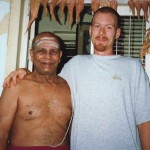By Todd Roderick and Stephanie Kohler from Ashtanga Yoga Atlanta

If transformation were easy, we’d have no need for any spiritual practice. Often, the most compelling testimonials about yoga are often from people who’ve changed themselves and their lives drastically, utterly altering what was most recognizable. Though some people disparage yoga as “soft,” the Indian perspective is quite the opposite: yoga has immense potential on many levels, beyond the physical. The entirety of yoga challenges practitioners mentally, emotionally, and spiritually. Some people learn that jobs, relationships, or lifestyle routines do not actually support the path to improved well-being. In the process of abandoning that which does not serve, pain frequently ensues. Triumph and its accompanying freedom, by definition, cannot occur without challenge.
The many faces of pain
Semantics often limits meaningful discussion about pain. Pains, really, because many sensations can be labeled as “painful.” Moreover, “injury” and “pain” are often used interchangeably, when in fact the distinction is vital for clearer understanding. Flourishing in times of ease comes naturally, yet life presents struggles. The discipline of any practice, by definition, entails moments that are not always enjoyable, even if the results are. Mastery, from athletic or mechanical to musical or creative, brings some frustration. Any Olympic athlete can confirm that dedication is not always fun. Self-mastery through yoga and meditation are no different. Far from always pleasant, they frequently bring up scary and painful experiences within the process of transformation. Not just physically, but mentally, emotionally, and spiritually. Moreover, the many ideas of pain spring not merely from direct occurrence in the past, but even the idea of or potential for pain. In other words, physical pain strongly resembles fear or frustration, both of which are types of mental pain.
The phrase “no pain, no gain,” depending on the definition of pain, can be a gritty truth or a harmful misconception. Certainly pain unchecked, pain unmitigated by mindfulness, will not precede healthy transformation—the harmful misconception. Yet pain that results from meeting challenges and handling them constructively is powerfully conducive to growth—for those who wish to avoid literal growing pains, the gritty truth. A more descriptive version could be “no growth in comfort, no comfort in growth.”
Asana pushes the body’s limits of muscle lengths and joint ranges of motion. Consequently, many yoga teachers in the West are hyper-sensitive about pain. (Again, the semantic difficulties of “injury” and “pain” can be problematic.) In the beginning, this awareness aligns with ahimsa (nonviolence), the first of the yamas (ethical abstentions). However, many yoga teachers both literally and figuratively bend over backwards to shield students from all discomfort, taking the principle of injury avoidance too far. This mentality can easily slip into the lure that all forms of yoga should always feel pleasurable. By that rationale, pain or discomfort demonstrates that a person is not practicing correctly. Again, different types of pain have difference significance. Deep intuition that something is harmful should be heeded. However, the Yoga Sutras repeatedly emphasize that the mind can and will mimic intuition. This can manifest in various types of painful emotions, such as fear, discomfort, or uncertainty. Acknowledging this tendency yields a more complete understanding; namely, that some painful experiences can signal that one is practicing correctly.
An unrecognized gift
Like many perspectives on practice, our confrontations with pain function as a good mirror for how we conduct our lives. Using painful moments in yoga practice as opportunities to learn and grow allows pain to serve rather than punish or prolong suffering. Life provides pain and will continue to do so until we learn its deeper lessons. By that rationale, to move through pain, instead of trying to escape it, we inevitably experience pain. In this case, however, we also derive the gift of growth. In the words of Kahlil Gibran: “Much of your pain is self-chosen. It is the bitter potion by which the physician within you heals your sick self.” A yoga practice that faces that pain, channels through it constructively, allows us to penetrate more profound levels of knowing and transcendence, catharsis and healing.
In that context, pain can be welcomed through acceptance. As Clarissa Pinkola Estés, a Jungian psychologist, explains, we begin to learn when pain becomes conscious. Thriving amidst adversity is a far greater challenge than avoiding it altogether. A life or a yoga practice based in avoidance of pain indicates the avoidance of not just challenges, but also the loss of potential for growth. A committed yoga practice provides moments of pain, in many faces, with varying levels of intensity. A specific posture may trigger pain or fear or frustration. Facing the practice as a whole may intimidate. Regardless of the situation, a consistent yoga practice teaches the consciousness necessary to transcend the tendency to avoid pain’s many facets. Instead, we observe feelings and responses more objectively. Stepping back, so to speak, from the mind’s conditioned responses to pain allows us to develop more constructive approaches to facing pain not only within practice, but in any capacity.
read more…
[…]just below, are some totally unrelated sites to ours, however, they are definitely worth checking out[…]…